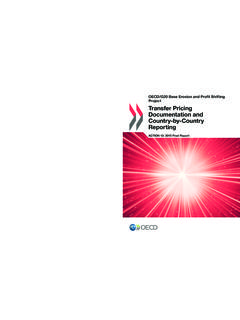Transcription of Proportionality in banking regulation: a cross …
1 Financial Stability Institute FSI Insights on policy implementation No 1 Proportionality in banking regulation: a cross - country comparison By Ana Paula Castro Carvalho, Stefan Hohl, Roland Raskopf and Sabrina Ruhnau August 2017 FSI Insights are written by members of the Financial Stability Institute (FSI) of the Bank for International Settlements (BIS), often in collaboration with staff from supervisory agencies and central banks. The papers aim to contribute to international discussions on a range of contemporary regulatory and supervisory policy issues and implementation challenges faced by financial sector authorities. The views expressed in them are solely those of the authors and do not necessarily reflect those of the BIS or the Basel-based Committees.
2 Authorised by the Chairman of FSI, Fernando Restoy. This publication is available on the BIS website ( ). To contact the BIS Media and Public Relations team, please e-mail You can sign up for e-mail alerts at Bank for International Settlements 2017. All rights reserved. Brief excerpts may be reproduced or translated provided the source is stated. ISSN 2522-2481 (print) ISBN 978-92-9259-088-8 (print) ISSN 2522-249X (online) ISBN 978-92-9259-079-6 (online) Proportionality in banking regulation: a cross - country comparison iii Contents Executive summary .. 1 Introduction applying Proportionality in banking regulation .. 3 Aspects of Proportionality embedded in the Basel framework.
3 4 Defining criteria for the application of Proportionality .. 5 Targeted areas of Proportionality .. 8 Concluding remarks .. 11 Annex: Examples of proportional approaches .. 13 The case of Brazil .. 13 The case of the European Union .. 14 The case of Hong Kong SAR .. 17 The case of Japan .. 18 The case of Switzerland .. 19 The case of the United States .. 20 References .. 22 Proportionality in banking regulation: a cross - country comparison 1 Proportionality in banking regulation: a cross - country comparison1 Executive summary The regulatory response to the 2007 09 international financial crisis resulted in a more robust but also more complex regulatory framework. The Basel standards, as developed by the Basel Committee for banking Supervision (BCBS), are designed to apply to large and internationally active banks.
4 But many jurisdictions have decided to apply the Basel standards to a wider set of banks. The additional complexity of Basel III has triggered discussions on the principle of Proportionality , ie on how best to tailor regulatory requirements to non-internationally active banks, especially smaller and less complex ones. The discussion about applying a proportional approach to banking regulation is not new. The Basel framework has offered a menu of approaches since the advent of Basel II. Several jurisdictions have implemented specific regulatory standards for smaller and less complex banks. Since the introduction of risk-based supervision, the principle of Proportionality has played an established role in day-to -day bank supervision.
5 This note compares the Proportionality approaches that have already been applied, or are planned, in six jurisdictions: Brazil, the European Union, Hong Kong SAR, Japan, Switzerland and the United States. These approaches differ considerably, in terms of criteria and the thresholds used to decide which banks are subject to a specific set of rules, and also in terms of the regulatory standards that are subject to a proportional implementation. The key feature of a Proportionality regime is the criteria used to identify the banks to which a proportional framework is applied. The criteria for identification/segmentation vary widely across jurisdictions, although a bank s size plays a major role. In addition to size, the bank s business model and business activities are critical considerations when applying a proportional regulatory treatment.
6 In practice, full Basel standards are generally enforced, as a minimum, on mid-sized to large banks. In many jurisdictions, banks with balance sheets of more than EUR 20 30 billion are generally subject to the full Basel standards. The United States and Brazil apply Basel-based standards to large international banks, although the alternative prudential requirements applied to other banks are not necessarily less stringent, and often align with Basel standards and principles. The criteria used in segmenting banks for possible exemptions in regulatory requirements follow different schemes. In three countries Brazil, Japan and Switzerland banks are divided into specific categories according to their size and/or international activity.
7 Banks in the same category are subject to a specific set of rules that differ from the ones applied to banks in other categories. By contrast, in the European Union, the United States and Hong Kong SAR, rules corresponding to specific Basel standards are adjusted for banks meeting set criteria, eg market risk can be measured according to a simplified method for banks with a small trading book. These two different schemes are often applied in 1 Ana Paula Castro Carvalho, Central Bank of Brazil; Stefan Hohl, Roland Raskopf, Bank for International Settlements and Sabrina Ruhnau, Deutsche Bundesbank. We would like to thank Kheng-Piew Ch ng, Alan Clifford, Rodrigo Lara Pinto Coelho, Adrienne Coleton, Anna Hewko, Daryl Ho, Thomas Odegard, Kenji Ooki, Nina Reiser, Otavio Ribeiro Damaso, Martin Sprenger, Uwe Steinhauser, Greg Sutton and Jean-Philippe Svoronos for their valuable input and advice.
8 2 Proportionality in banking regulation: a cross - country comparison combination, meaning that specific exemptions can be granted in addition to the selection of banks into different regulatory Another relevant feature is the scope of the regulatory adjustments for smaller or less complex banks. These proportional adjustments aim at reducing the operational burden for banks. Observed exemptions from the Basel standards often apply to the liquidity framework, the disclosure requirements, counterparty credit risk, the large exposures framework and the measurement of market risk. Other regulatory areas, which are more principle-based by design, such as Pillar 2 and interest rate risk in the banking book, offer more scope to further reduce the regulatory burden.
9 The Proportionality strategy should acknowledge the limits posed by other relevant policy objectives. In particular, regulators must weigh the implications for financial stability and for the domestic competitive environment. Policy choices must face complex trade-offs in this respect. It would seem reasonable to aim for a proportional compliance and reporting burden for smaller and less complex banks but without jeopardising their minimum desired solvency and liquidity. In other words, Proportionality should entail rules which are simpler but not necessarily less stringent. 2 Switzerland, for example, makes the principal distinction between banks in categories 1 3 and 4 5 and also grants specific exemptions independent of the categorisation.
10 Proportionality in banking regulation: a cross - country comparison 3 Introduction applying Proportionality in banking regulation 1. Global coordination has contributed to the development of more consistent and comparable regulatory and supervisory standards. International standards are required to ensure that all banks which can transmit risks across borders meet sufficiently stringent solvency and liquidity requirements, both to facilitate a level playing field at the global level and to favour the integration of global banking markets. 2. An important feature of Basel I, II and III is that they are not designed to be applied to the whole banking system in all jurisdictions. The Basel core principles for effective banking supervision do not require jurisdictions to apply the capital adequacy regimes of Basel I, Basel II and/or Basel III to non-internationally active banks.
















